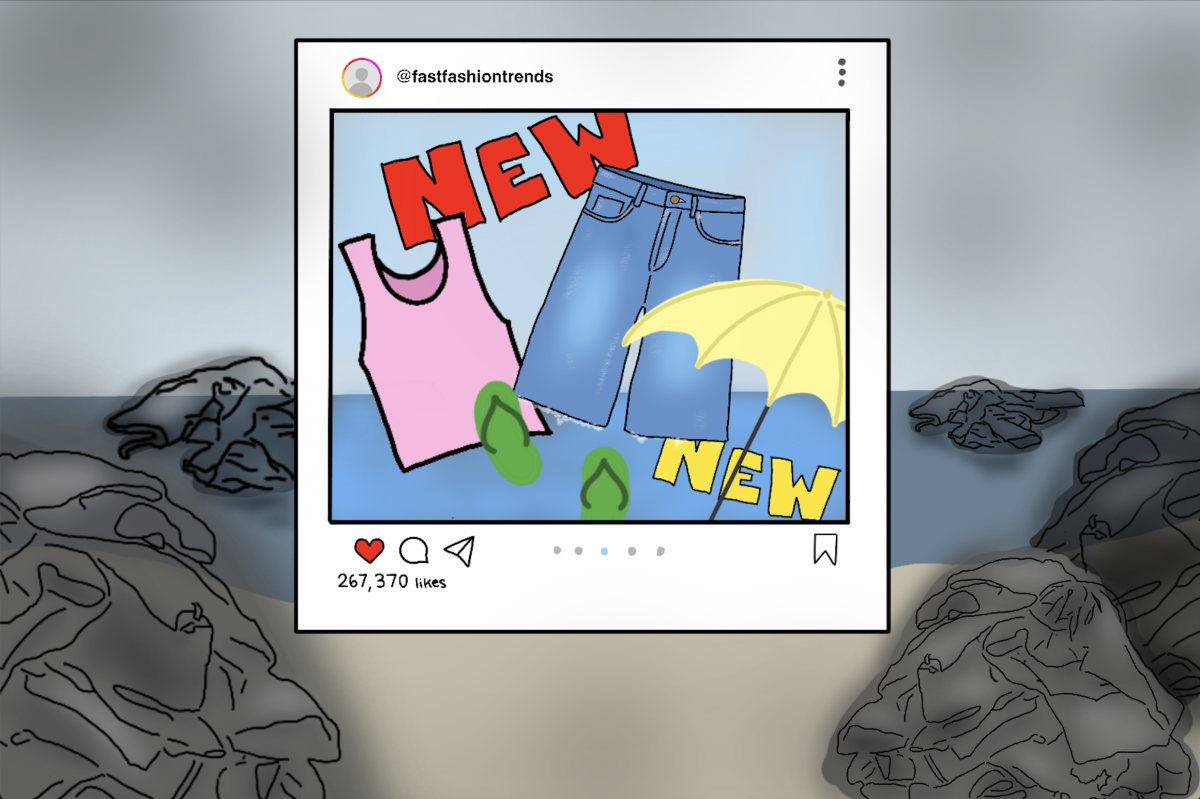No matter which high street you stroll down in London, you’re bound to find a Zara or H&M offering quick, affordable clothing. While such shopping is tempting, young generations often overlook the environmental destruction caused by these fast fashion brands. Does convenience really outweigh the importance of maintaining a healthy environment?
As summer rolls around and the weather gets warmer, many students seek inexpensive, trendy clothing to temporarily update their wardrobes. In such a hunt for budget-friendly pieces, many purchase from companies that utilize harmful production methods. Once the season ends, many of these garments are thrown away, never to be worn again. Without realizing it, our collective consumer habits build up to immense environmental damage.
We must take action and responsibility for the environmental damage caused by supporting the fast fashion industry.
Fast fashion is a type of global production that creates and sells clothing quickly and cheaply. According to the BBC, a survey conducted by the environmental charity Hubbub concluded that 40% of 16 to 24-year-olds purchase from fast fashion brands online. Younger generations are enticed by easy accessibility and low prices, causing students to unconsciously promote polluting companies. According to Imperial College London, the fast fashion industry has increased water pollution, soil contamination and global warming so expeditiously that the destruction caused is already beginning to be irreversible.
Water pollution is one of the many significant consequences of the fast fashion production process. According to The Guardian, popular brands such as Zara produce viscose, a cheap alternative to cotton and polyester. This production method releases toxic chemicals that intensely pollute water. For example, a report from the Changing Markets Foundation found that in countries such as Indonesia and China, contaminating waste infiltrates these countries’ water systems, prohibiting access to clean water — a fundamental resource that all humans should have the right to use. We have a moral duty to ensure the well-being of others by acknowledging our own problematic consumerist behavior, particularly in situations where our harmful actions can be prevented.
While not heavily highlighted, soil contamination has become a rising problem due to fast fashion industries. According to Klas Kristiansson, the co-founder of Apparel Entrepreneurship, the effects of fast fashion prohibit soil from performing its foundational tasks of naturally creating healthy plants and absorbing carbon dioxide. The fast fashion industry and its production process involve the use of toxic chemicals to grow crops, as well as the intense overgrazing of grasslands during wool production. Both stand as examples of the many environmentally damaging habits that still have not been fully recognized by society. Unless kept healthy, soil can no longer be used for its primary purposes and thus will decrease the world’s supply of fundamental resources. Contaminated soil cannot successfully grow healthy plants, which would result in a decreased food supply. This food shortage would exacerbate other societal issues including poverty and hunger, worsening the economic state of our world.
Fast fashion is also contributing to the global warming crisis. The U.N. Environment Program predicts the fast fashion industry will spend a quarter of the world’s carbon budget by 2050. Considering how quickly we are causing environmental destruction, future generations will be burdened with cleaning up after our messes with little time and solutions left. Thus, we must reduce the use and production of fast fashion clothing before it is too late to reverse the damage done.
Some may argue that other human activities such as aviation companies and power plants are the main contributors to environmental damage and, therefore, should cause greater concern compared to the fast fashion industry. Regardless, fast fashion is a man-made industry that exists for human enjoyment and leisure rather than necessity. Therefore, in comparison to the use of planes and energy, society is not as reliant on fast fashion in our everyday lives. This means creating sustainable alternatives to fast fashion is more attainable than quickly establishing a different form of transportation or energy form.
We must improve our daily lifestyles to create a more sustainable world within the next decade. The U.N. Environment Program mentions the large-scale solution of the GumDrop project in Amsterdam, where gum is recycled to create shoes with a newly manufactured rubber called Gum-tec. This is just one creative example of how garments can be produced in a safe way that benefits the environment, which is something that many brands can take inspiration from in the future.
On a smaller scale, individuals can take action by thrifting or purchasing pre-owned clothes. Many local shops go unnoticed, however, they have recently increased in popularity as thrifting has become a rising trend on social media. Numerous second-hand stores are available throughout London, with multiple shops open on the St. John’s Wood High Street. By becoming more conscientious about these environmental issues, we can apply sustainable practices and solutions that will gradually revive our natural environment over time.











